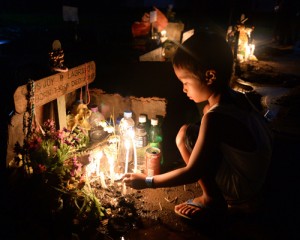YEARENDER2013
The country’s power sector faced many challenges this year, but Super Typhoon Yolanda is the most formidable.
Energy Secretary Jericho Petilla said that Yolanda left the biggest impact on the power industry.
The storm, which swept across Central Philippines on November 8, toppled power lines and left dozens of towns without electricity for days if not weeks.
“For me, the most significant challenge for the year is Yolanda. Its effect is spread out across the country. Restoring the power in the area has now become a mission because it is the only way we can give hope to people,” Petilla said.
As of Wednesday, 98 percent of electricity in Eastern Visayas has been restored. Only about six or seven cities are still without power.
Petilla had said vowed to resign if power is not restored in all typhoon-devastated areas by December 24.
He has put the overall cost to bring back power at P6.5 billion, up from the initial estimate of P2 billion.
To raise funds for the massive restoration effort, Petilla proposed that government maximize the discounts from insurance companies, but power consumers still have to shoulder part of the expense.
Early in December, customers of the Manila Electric Co. (Meralco) were jolted by the news that Meralco will raise its rate by P4.15 per kilowatt-hour, the highest increase in Philippine history.
Meralco blamed the increase on the shutdown of several power plants, which happened while the Malampaya natural gas plant was undergoing maintenance.
Meralco said that because of the shutdowns, it had to purchase power at a higher price from the Wholesale Electricity Market (WESM).
A day after the Energy Regulatory Commission (ERC) approved Meralco’s rate increase, the DOE announced that it will investigate if there was collusion among power suppliers.
“The price hike was expected. However, nobody expected that kind of increase. ERC [Energy Regulatory Commission] is doing market intervention right now,” Petilla said.
DOE Undersecretary Raul Aguilos told the House committee on energy that eight power plants shut down at the same time, raising suspicion that power producers may have colluded to manipulate prices.
On Monday, the Supreme Court issued a temporary restraining order stopping Meralco from collecting the higher rate.
Despite the massive destruction left by Yolanda, Petilla said 2013 was an interesting and productive year.
He said the DOE was able to carry out several programs and introduced new services that have long been pending.
These include the launch of the Retail Competition and Open Access (RCOA) program, which allows big power consumers such as industries and businesses to decide which power distributor it will get its electricity from.
In June, the DOE, ERC, and Philippine Electricity Market Corp. (PEMC) launched the commercial operations and integration of RCOA into the WESM.
“The next is IMEM [Interim Mindanao Electricity Market]. We made some actions regarding that. It has been idle for so long and now is up and running even if it’s not yet perfect,” Petilla said.
IMEM is an electricity market in Mindanao that is structured to help address the region’s supply shortfall.
The DOE set new criteria in giving Feed-in-Tariff (FIT) eligibility to investors. FIT is a renewable subsidy scheme for companies. Firms who will be able to operate their renewable energy project will be the first ones to get FIT eligibility.
Petilla said the agency is “moving forward and fast” in implementing new services or programs or even in terms of approving the service contracts.
Next year, the DOE will start some of its pending projects like the reserve market and the start of the Fifth Philippine Energy Contracting Round (PECR 5).
PECR allows investors to bid for contracts for exploring, developing and producing oil and gas sites.
“PECR 5 is scheduled for the first quarter. We are now reviewing the available areas that can be bid out. We are confident that there will be interested investors,” Petilla said.
The Energy Reserve Market, a program designed to limit power outages, is to be launched on March 26.


